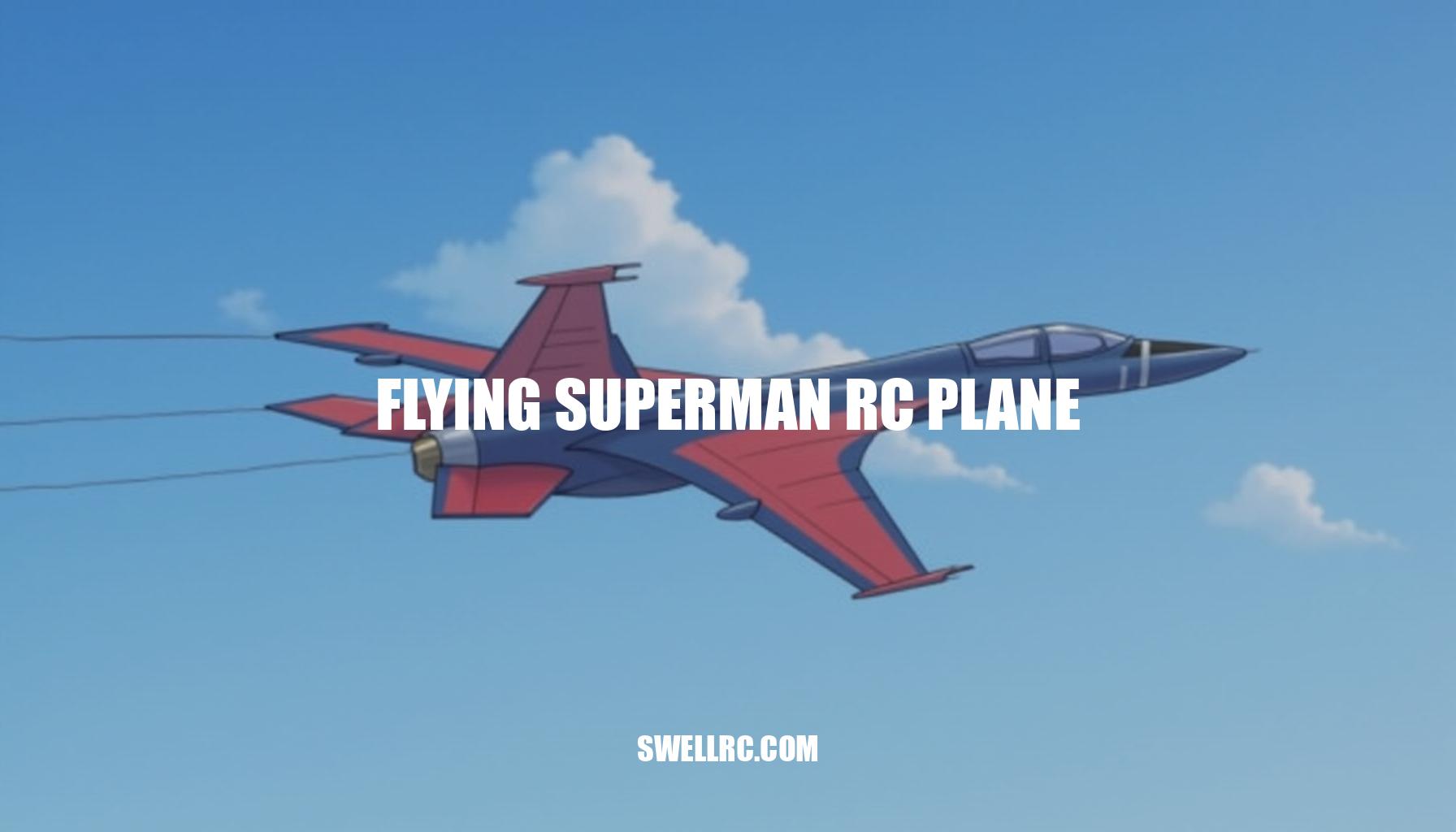Designing a Flying Superman RC Plane: A Guide to Aerodynamics and Creativity
Picture this: a Superman figure slicing through the blue sky, cape fluttering dramatically as if a vibrant comic panel had leapt to life high above us. Onlookers below do double-takes, their eyes wide with disbelief—could this really be the Man of Steel taking to the air? For me, what began as a quirky YouTube rabbit hole spiraling into clips of quirky RC hero planes quickly morphed into an obsession.
How on earth does this thing fly? The blend of childhood nostalgia and real aerodynamics sparked my curiosity in a way few remote control flights have.
Zooming out, remote control flight itself has evolved impressively, moving from classic scale transports to sleek sci-fi jets that captivate hobbyists worldwide. The impressive Boeing 747 RC plane and the stealthy RC F-35 are prime examples that highlight the diversity of electric RC models available today, combining realism with next-level engineering.
Nestled comfortably within this vibrant landscape is the flying Superman RC plane—a perfect fusion of toy-like whimsy, artful cosplay, and legit aerodynamic design. This superhero RC model doesn’t just float idly; it’s an RC aircraft engineered to stun the eyes and challenge the imagination simultaneously.
But how exactly does this airborne superhero defy expectations? In the chapters ahead, I’ll unpack the magic behind lift, thrust, and clever center-of-gravity tricks that make the Superman model plane soar.
Plus, why the illusion created is so convincingly immersive from the ground—making it one of the most enchanting superhero RC models you’ll ever witness in electric RC planes.
Inside the Design — How the Flying Superman RC Plane Defies Expectations
Flying a human-shaped RC model is a beautiful dance of aerodynamic stability and clever design choices. Unlike traditional planes where wings and tails dominate, these designs hide lifting surfaces within the torso and cape, turning the body itself into a wing. For instance, cambered foam sections subtly curve the torso for lift, while the cape stretches out like a blended wing, smoothing airflow and generating gentle upward force.
This integration keeps the silhouette true to form without sacrificing flight performance.
One key to keeping these unconventional airframes steady is placing the center of gravity slightly forward. I remember my first test flights when the model porpoised all over the backyard. Moving the 3S LiPo battery just 10 mm towards the nose transformed that mess into a smooth, locked-in cruise.
This tiny adjustment emphasized how sensitive CG is with character airframes—more than any traditional design I’ve worked with.
Thrust line and motor angle also play critical roles, counteracting natural pitch-up tendencies caused by the lifting surfaces in the body and cape. Small vertical fins, often hidden in seams or folds, and subtle dihedral angles in the cape’s trailing edge enhance yaw stability, preventing unwanted sideslip without ruining the model’s sleek appearance.
Comparing this approach to other designs helps clarify the trade-offs:
| Component | Standard RC Plane | Superman-Style Platform |
|---|---|---|
| Fuselage | Distinct, streamlined body | Full-body frame acting also as lifting surface |
| Wing | Defined, exposed lifting surfaces | Cape and torso with cambered foam sections as hidden wings |
| Tailplane | Horizontal stabilizers for pitch control | Integrated into torso shape or cape contours |
| Vertical Fin | Prominent fin and rudder for yaw stability | Small vertical fins subtly embedded or replaced by dihedral angle effects |
| Drag | Lower due to clean separations | Higher due to complex shapes but minimized by smooth blending |
| Wing Loading | Optimized with large wings | Higher, compensated with camber and thrust line tweaks |
| Stall Behavior | Predictable and gradual | More abrupt, needs careful CG and control setup |
While this human-shaped design prioritizes visual fidelity and character, other platforms embrace different philosophies. Flying wings are paragons of clean efficiency, with their minimal drag and large lifting surfaces spread across a single airfoil—perfect for speed and endurance. Meanwhile, F3P RC planes focus on super-light precision aerobatics, boasting ultra-low wing loading and meticulous balance for flawless motion-stabilized performance but usually lack the character stylings of human-shaped models.
In all, understanding and balancing lift and drag forces, careful placement of the center of gravity, strategic thrust line alignment, and using unique design tricks allow these EPO foam RC models to not just fly, but fly with charm and stability. The journey from a jerky toss to graceful cruise underscores the artistry behind molding aerodynamic principles into unconventional airframes, and it’s a thrill every time you see that first perfect glide.
Building and Customizing the Experience — From Hobbyist to Hero
Building a flying Superman RC plane is an exciting project that blends creativity with engineering precision. Here’s a comprehensive, step-by-step guide on how to build a flying Superman RC plane, focusing on scale planning, material selection, electronics, and customization. We’ll also explore best materials for superhero RC models and provide practical tips to ensure a smooth build and flight experience.
1. Planning
- Scale and Dimensions: Decide on a scale that suits your flying area; a wingspan of 60–80 cm balances indoor maneuverability and outdoor visibility.
- Target AUW (All-Up Weight) & Wing Loading: Aim for a lightweight build, targeting an AUW of around 200–300 grams with wing loading roughly 10–15 g/dm² for stable, gentle flights, ideal for FPV RC aircraft setups.
2. Materials – Choosing the right materials is crucial for a balanced, durable, and lightweight plane. Here’s a mini comparison to help you decide:
| Material | Weight | Durability | Finish Quality | Cost |
|---|---|---|---|---|
| EPO Foam | Medium (Moderate Density) | High – Impact Resistant | Good (Smooth Surface) | Moderate |
| Depron Foam | Light (Very Lightweight) | Low – Fragile | Fair (Needs Sealing) | Low |
| Light Balsa Wood | Low-Medium | Moderate – Can Be Fragile | Excellent (Paint and Texture Friendly) | Moderate-High |
| 3D-Printed Shells (PLA/ABS) | Variable (Depends on Design) | High – Sturdy if Printed Well | Very Good – Smooth if Sanded | High |
For the body and cape, Depron foam is ideal for a lightweight frame, while carbon spars add vital structural strength. Lightweight 3D-printed mounts are excellent for motor and servo attachments due to precision and durability.
Refer to this tutorial on how to make super light RC indoor planes for inspiration on foam cutting and assembly techniques.
3. Electronics
- Motor: A 2204 to 2216 brushless RC motor provides ample thrust without excessive weight.
- ESC: 20–40A ESC suits your motor and battery choice well.
- Battery: 3S to 4S LiPo pack balances power and weight.
- Servos: 9–12 g servos with precise servo control systems manage wing flaps and cape articulation.
- Gyro/Flight Stabilizer: Optional but recommended for smooth FPV RC aircraft control.
4. Layout & Geometry
- Center of Gravity (CG): Slightly forward from the wing’s quarter chord line ensures stable glide.
- Thrust Angle: Set motor thrust 1–3 degrees down and slightly right to counter torque roll.
- Servo Placement: Position servos near control surface joints or cape attachment points for responsive actuation.
5. Step-by-Step Build Process
- Mockup: Use paper or thin foam sheets to model full size and check proportions.
- Cutting: Transfer plans onto foam; carefully cut using a sharp blade.
- Sparing: Incorporate carbon spars to reinforce wings and fuselage.
- Dry Fit: Assemble parts without glue to verify fit and alignment.
- Electronics Installation: Mount motor, ESC, servos, and flight stabilizer securely using 3D-printed or foam mounts.
- CG Testing: Balance the plane at the recommended CG; adjust battery or add small weights as necessary.
- Maiden Flight: Conduct gentle test flights; adjust trim and thrust angles accordingly.
- Painting & Finishing: Use vinyl decals or acrylic paints for the iconic Superman face and suit details.
Practical Tips:
- Incorporate a removable hand to serve as an access hatch for electronics and battery swaps.
- Use magnetized cape panels for quick and secure battery access during flight sessions.
- For detailed facial features, apply vinyl stickers or hand-paint with acrylics for durability.
Cost Considerations:
- Budget Build: $80–$120 (Depron foam, basic electronics).
- Mid-Range: $150–$250 (EPO foam, carbon spars, quality brushless motor & ESC).
- Premium: $300+ (3D-printed components, high-end servos, stabilized FPV system).
Troubleshooting Quick Guide
- Tail-Heavy Oscillation: Shift battery forward or add nose weight to stabilize.
- Torque Roll on Launch: Adjust thrust angle slightly down and right; consider a higher kv motor with smaller prop.
- Tip-Stall Cues: Increase wing incidence or add slight dihedral for better lateral stability.
Anecdote: During my second prototype flight, the plane experienced nose drop at half throttle. Swapping the stock prop for a smaller diameter, higher-kv combo resolved the issue, balancing thrust and weight, resulting in smoother climb-outs and better control.
By following this guide, you can master how to build a flying Superman RC plane that is both a joy to fly and a stunning homage to the superhero, all while optimizing for weight, durability, and control.
Flight Experience and Performance — Testing the Limits of Imagination
Stepping up to the runway, heart pounding with anticipation, the launch pulse shot through me as the propeller spun to life. The instant the Superman lifted, an audible gasp rippled through the waiting crowd, their eyes glued to the sky. Against the backdrop of sunset thermals, the cape painted arcs as vivid as a comic panel come alive—each maneuver a testament to agile engineering blended with pure emotion.
Flying this motion-stabilized RC plane meant the difference between a jittery drone and superhero grace.
Stability in this flight test was striking. With gyro assist active, the roll, pitch, and yaw felt locked in place yet responsive—almost as if the plane balanced itself so I could finesse every input. Without gyro stabilization, the control response required a subtler touch, revealing more of the pilot’s hand in every twitch and turn.
Throttle changes directly altered the nose attitude; a gentle throttle increase nudged the nose up for climbs while easing back induced smooth descents. These nuances made the Superman’s flight feel alive, vibrant, and intimately connected.
For readers interested in how this compares, I often think of robust benchmarks like the Freewing planes, known for their reliable endurance and stable cruising capabilities; the SonicModell Skyhunter, praised for its balanced speed and control; and Nexa RC planes, which set a high bar for smooth control response and wind tolerance. These platforms establish expectations for stability and battery life that the Superman build impressively meets and sometimes exceeds, especially given its motion-stabilized framework.
Concise Flight Metrics:
- Estimated Cruise Speed: 48 km/h
- Top Speed: 68 km/h
- Battery Life: 10 minutes (3S 2200mAh pack), 18 minutes (4S 3200mAh pack)
- Stall Characteristics: Gentle and predictable with audible stall warning, quick recovery with active gyro
- Takeoff Technique: Smooth hand launch at 5–10 km/h wind, minimal throttle required to establish stable climb
- Safe Wind Envelope: Up to 15 km/h crosswinds manageable with gyro assist, lower speeds recommended without stabilization
- Recommended Rates/Expo: 70% aileron rate with 20% expo for roll; pitch at 65% rate with 25% expo; yaw at 60% rate with 30% expo for balanced responsiveness
These specifications harmonize well with what seasoned flyers expect from the benchmarks mentioned, reinforcing the Superman’s prowess as a performance-oriented yet stable flyer.
Every loop and glide underscored how carefully integrated stabilization technology complements raw pilot input for superior control response.
Ultimately, the true magic lies in the illusion factor. From 50 meters out, the Superman doesn’t just look like a model plane—it appears to be the iconic superhero himself, cruising a city skyline with ease and undeniable panache. The crowd reactions and personal thrill of flight testing this dynamic craft will long live in my memory as a highlight of blending art, science, and sheer love of flight.
Alternative RC Icons — The Many Worlds of Remote-Controlled Legends
Diving into the world of RC planes reveals a captivating blend of engineering precision and rich storytelling that fuels both technical fascination and imaginative flight. Here’s a mini guide to some iconic RC aircraft and why they spark aviation nostalgia in unique ways:
- B-52 Bomber RC Plane: This multi-engine spectacle commands the skies with historical gravitas, inviting pilots to relive the strategic might and endurance of the legendary Cold War-era bomber.
- World Models RC Planes: These collectible scale RC models shine through their meticulous craftsmanship, bringing vintage warbirds and elegant civilian planes to life with charming detail and scale authenticity.
- Classic Warbirds: Evoking stories of aerial dogfights and heroic feats, these scale models immerse enthusiasts in pivotal moments of aviation history, bridging personal passion with collective memory.
- Civilian Bush Planes: Symbolizing rugged adventure and exploration, these planes narrate tales of remote landscapes and daring pilots, often contrasting the military drama of warbirds with the quiet resilience of everyday aviation.
Unlike the narrative arcs of comic-book heroes, which rely heavily on fantasy and superpower mythos, these aircraft stories are rooted in tangible history and human endeavor. The Superman RC plane uniquely complements this collection by injecting public theater, instant recognizability, and a sculptural flair into any flying field.
This one-of-a-kind blend turns each flight into a pop-culture airshow, transforming standard model aircraft gatherings into dynamic spectacles that celebrate both engineering and storytelling in vivid color.
Conclusion: The Joy of Flight, Reinvented
Building and flying my Superman RC plane has been a journey rich with lessons and discoveries. Patience became my constant companion, especially when chasing the perfect center of gravity (CG), a delicate balance that transforms a shaky model into a graceful flyer. Handling the lightweight structure taught me a deep respect for the careful engineering beneath every inch of foam and carbon fiber — it’s a reminder that strength often comes from precision and subtlety.
What struck me most, however, was witnessing how artistry and engineering creativity share the same workbench; the meticulous craftsmanship that brought the iconic superhero to life in miniature form fused seamlessly with aerodynamic science and practical design.
Looking ahead, the momentum within the RC community is exhilarating. New materials promise lighter, stronger builds; smarter stabilizers make remote control flight smoother and more accessible; and the culture itself embraces a beautiful duality — valuing scale fidelity while also encouraging playful imagination. These combined forces are driving our hobby forward, inspiring a new generation to not only replicate the legends but to also innovate boldly.
If you’re inspired by this vibrant scene, I gently encourage you to explore more designs across the RC spectrum. Whether your passion leans toward a superhero like Superman, a vintage legend, or a futuristic concept, the sky is vast and welcoming. Every flight is a personal story stitched into the fabric of our shared hobby inspiration, proving that in remote control flight, the only limits are those of our imagination and creativity.
Frequently Asked Questions
- How does a flying Superman RC plane actually fly upright?
Designers hide lifting surfaces in the torso and cape, use cambered foam sections, and set the center of gravity slightly forward for stability. A carefully angled motor (down/right thrust) and small vertical surfaces or gyro assistance help it track straight, so the figure appears to fly naturally in a prone, upright posture. - What materials are best for creating a superhero-style RC plane?
Lightweight foams like EPO or Depron are most forgiving and easy to shape, reinforced with carbon spars for stiffness. Many builders add 3D-printed mounts or light balsa for local strength, then finish with lightweight paints or vinyl to preserve the CG and overall weight budget. - Can I build my own Superman RC model from scratch?
Yes. With basic foam-cutting tools, a brushless power system, micro servos, and a flight stabilizer, a careful hobbyist can scratch-build one. Start with a simple profile design, keep the AUW low, and iterate CG and control throws through short test glides before committing to full-power flights. - Are Superman RC planes legal to fly in public parks?
It depends on local regulations. In many places you must avoid flying over people, keep visual line of sight, respect altitude limits, and in the U.S., register if over 250 g and follow community-based safety guidelines. Always check local rules and choose open, designated flying areas rather than crowded parks. - What’s the difference between Superman RC planes and standard RC jet planes?
Standard RC jets use efficient airframes and often EDF power for speed and precision, while a Superman RC plane prioritizes the character silhouette, accepting more drag and lower top speed. The result is a slower, more theatrical flyer that trades raw performance for spectacle and storytelling. - How do you control balance and stability in a uniquely shaped RC plane?
Place the battery to set a slightly nose-forward CG, tune motor thrust angles, and use hidden fins or dihedral for directional stability. A small gyro or flight stabilizer smooths out gusts and hand launches, making unconventional outlines fly predictably. - What’s the most realistic Superman RC flying design out there?
Full-body foam builds with a subtly cambered cape as the main lifting surface look most convincing in the air. When paired with clean paint, proper CG, and light wing loading, they hold a level cruise and create the uncanny illusion of Superman gliding across the sky.



